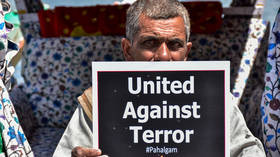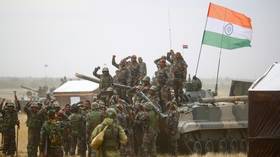Days before India’s ‘Operation Sindoor,’ Islamabad suspended the 1972 agreement with New Delhi that aimed to establish lasting peace between the two neighbors
India launched ‘Operation Sindoor’ on the night of May 7, targeting terrorist infrastructure in Pakistan in retaliation for a deadly terrorist attack in Pahalgram, Kashmir last month. New Delhi stated that it hit at least nine targets.
“Our actions have been focused, measured, and non-escalatory in nature. No Pakistani military facilities have been targeted. India has demonstrated considerable restraint in the selection of targets and method of execution,” the Indian government said in a statement.
Pakistan’s Prime Minister Shehbaz Sharif descried the strikes as a “cowardly” attack and said Islamabad “has every right to respond forcefully to this act of war imposed by India, and a forceful response is being given.”
Tensions between India and Pakistan escalated to military actions following the killing of 26 innocent vacationers in Pahalgam, Kashmir by Pakistan-backed terrorists in a Hamas-style terror attack.
Pakistan Army and Inter Services Intelligence (ISI) links were established by India’s National Investigation Agency days after the mass killing. The public was angry, and sought appropriate revenge.
A wide range of diplomatic and economic measures were announced by both nations following the attack. Remarkably, India has put the 1960 Indus Water Treaty (IWT) in abeyance for the first time since the pact was inked by the two neighbors. Rejecting India’s move to suspend the IWT, Pakistan warned that any diversion of water will be treated as an ‘Act of War.’ Islamabad also said that it would hold “in abeyance” its participation in all bilateral agreements with India, including the landmark 1972 Simla Agreement.
Pakistan pledged a full-spectrum national power response to any threat against its sovereignty, put its armed forces on high alert, and began selective mobilisation. Most measures were quite expected. But by suspending the Shimla Agreement, Pakistan unwittingly handed over big advantage to India.
What is the Shimla Agreement?
The Shimla agreement between India and Pakistan was signed on July 2, 1972 at Barnes Court (Raj Bhavan) in the town of Shimla in the Indian state of Himachal Pradesh, between then-Indian Prime Minister Indira Gandhi and her Pakistani counterpart Zulfikar Ali Bhutto. It was ratified on July 15, 1972 (by Pakistan), and August 3, 1972 (by India), and became effective the next day.
The agreement had come in the wake of Pakistan’s comprehensive defeat in the 1971 war that split the country and created independent Bangladesh.
The agreement stated:“The Government of India and the Government of Pakistan are resolved that the two countries put an end to the conflict and confrontation that have hitherto marred their relations and work for the promotion of a friendly arid harmonious relationship and the establishment of durable peace in the sub-continent, so that both countries may henceforth devote their resources and energies to the pressing task of advancing the welfare of their peoples.”
The document was meant to lay the foundation of a peaceful and stable relationship between the two nations. It was decided that the two countries are resolved “to settle their differences by peaceful means through bilateral negotiations or by any other peaceful means mutually agreed upon between them.”
The treaty mandated that the two countries resolve issues bilaterally, and superseded the United Nation’s resolution on Kashmir. Perhaps more importantly, under the agreement, India and Pakistan established the Line of Control (LoC), previously called the Ceasefire Line, making it a quasi-border between the two nations.
New Delhi succeeded in persuading Islamabad to change the name of the ceasefire line to the Line of Control (LoC), thus delinking it from the UN-imposed 1949 ceasefire line and highlighting that Kashmir was now a purely bilateral matter between India and Pakistan.
The treaty clearly stated that Indian and Pakistani forces must be withdrawn to their respective sides of the “international border.” That in Jammu and Kashmir, the LoC resulting from the cease-fire of December 17, 1971, shall be respected by both sides without prejudice toward the recognised position of either side.
Neither side shall seek to alter it unilaterally, irrespective of mutual differences and legal interpretations. India returned around 13,000 square kilometers of land taken in battle on the western border but retained some strategic areas, including Turtuk, Dhothang, Tyakshi, and Chalunka in Chorbat Valley, covering more than 883 square kilometers, so as to facilitate lasting peace. Both sides further agreed to refrain from the threat or the use of force in violation of the LoC.

The fact that there has only been one limited war since the agreement was signed reflects its effectiveness.
Some Indian bureaucrats later argued that a tacit agreement to convert this LoC into a international border, was reached during a one-on-one meeting between the two heads of government. Pakistani bureaucrats have denied any such thing. Nor was that acceptable to Indian public.
The Shimla agreement called on both sides to resolve all issues bilaterally. But Pakistan never respected this part of the treaty, and has taken matters to an international level, especially by doing chest-beating over Kashmir at the UN. The latest example of this attitude is Pakistan’s outcry over the Abolition of Article 370 by the Narendra Modi-led government in 2019. One critical clause was that “both shall prevent the organisation, assistance or encouragement of any acts detrimental to the maintenance of peaceful and harmonious relations.”
Pakistan has been engaging in cross-border terrorism as a foreign policy tool to bleed India and to foster separatism in Kashmir, as well as to keep the Indian Armed Forces pinned down. Some of the major Pakistan-sponsored Islamist attacks against India have included a terrorist attack on the Parliament of India in New Delhi on December 13, 2001, the attack on the Akshardham temple in Gandhinagar in 2002; the Mumbai train blasts in 2003; twin blasts at Gateway of India and Zaveri Bazaar in Mumbai in 2005, Delhi bombings and 2006 Mumbai train bombings, train blasts in Jaipur in 2008, and the tragic Mumbai attacks in November 2008. The latest large-scale attacks occurred in Kashmir: a deadly terrorist attack on the Army camp in Uri killed 17 Indian soldiers and an attack on the military convoy in Pulwama resulted in the death of 40 personnel.
From then to now
Islamabad believes that by suspending the treaty it can once again take all issues to the UN or other bodies and invite third parties to intervene in the India-Pakistan disputes. But by suspending the Shimla agreement, the sanctity of the LoC becomes open-ended. It will be possible for either side to unilaterally take advantage and try violate it to gain ground.
India is more powerful, both militarily and otherwise, and will have the advantage. Pakistan tried to breach the LoC in 1999, resulting in the Kargil War, where Pakistanis were not only thrown out but also faced a humiliating defeat and very high casualties. Earlier, in 1984, Pakistan attempted to take control of the Siachen Glacier, an Indian territory demarcated by the Karachi agreement. In response, India launched Operation Meghdoot in 1984, gaining full control of the glacier.

With the suspension of the Simla Agreement, New Delhi is free to use military options without violating any treaty. These options could be many. India could pro-actively target terrorist camps across the LoC in order to slow or stop terrorist infiltration. India could regain territory in critical sectors, especially gains like the Haji Peer Pass, that it had earlier frittered under international pressure. There are other sectors where India can create greater buffer zones to reduce threats to the Srinagar-Leh highway.
When the treaty was signed, Pakistan had the support of the West, particularly the US, because Washington needed Pakistan for its operation against the Soviet Union in Afghanistan.
Things have changed ever since. Today the world is wooing India. India is a mature democracy with a powerful economy. It is a significant military power, too. Russia, Europe, the US, the Arab world, and even China need India for economic reasons.
India can now use the leverage it has over major powers to isolate Pakistan. It was encouraging to note that when the New York Times reported that the Pahalgam tourists were gunned down by “militants in Kashmir,” the US House Foreign Affairs Committee rectified the headline, referring to the gunmen as “terrorists.” India’s ties with China are also improving – causing insecurity in Pakistan.
Peace and stability in question
The Shimla agreement had not prevented the relationship between the two countries from deteriorating to the point of armed conflict even before – in the Siachen glacier or during the Kargil War of 1999.

The prerequisites for reconciliation, good neighborliness and durable peace between the two, has been breached repeatedly by Pakistan sponsored terrorism. They were expected to refrain from the threat or use of force against the territorial integrity or political independence of each other, this too has been violated. Pakistan’s army has repeatedly vowed to avenge the humiliating defeat and surrender of 93,000 able-bodied soldiers, “throwing peace into the wind.”
The progressive normalising of relations as envisaged by the treaty was not allowed to happen by Pakistan’s army, which has de-facto run the country since 1947. Pakistani Army’s power flows from the insecurity of the nation’s masses. Steps that were to be taken to promote travel, trade, and cultural relations kept seeing setbacks. The suspension of the treaty has raised concerns about the future of peace and stability in the region, especially regarding the LoC in Jammu and Kashmir.
The suspension could potentially revive the proxy warfare tactics that the Simla framework aimed to curb. It may not have immediate tactical consequences, but could open the door to greater diplomatic and military brinkmanship. Revival of hostilities or border instability could derail developmental and democratic consolidation efforts in J&K’s post-Article 370 abrogation. The escalation conflict between two nuclear-armed states have already raised alarms in the international community, prompting calls for restraint and dialogue.
The suspension of the Simla Agreement has provided India with an opportunity to recalibrate its security and diplomatic strategies. It also strengthened the case for Pakistan’s re-listing in the Financial Action Task Force grey list.
By disregarding the Simla Agreement, Pakistan has done a great favour to India and Prime Minister Modi to reclaim Pakistan-occupied Kashmir, something that the entire political class of India would support. India has nearly $680 billion in foreign exchange reserves, while Pakistan’s are $15 billion. Pakistan cannot sustain a conflict. The extent of armed conflict will be graded. It is time to wait and watch as things unfold.
The statements, views and opinions expressed in this column are solely those of the author and do not necessarily represent those of ReadNOW.